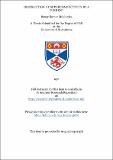Files in this item
Destruction of superconductivity by a current
Item metadata
| dc.contributor.advisor | Allen, J. F. | |
| dc.contributor.author | Mukherjee, Benoy Kumar | |
| dc.coverage.spatial | 118 p. | en_US |
| dc.date.accessioned | 2018-06-27T15:14:41Z | |
| dc.date.available | 2018-06-27T15:14:41Z | |
| dc.date.issued | 1971 | |
| dc.identifier.uri | https://hdl.handle.net/10023/14670 | |
| dc.description.abstract | We have carried out an experimental investigation of the resistance transition in Indium and Thallium wires when superconductivity is destroyed by a current. Our results, as well as those obtained previously by other workers, do not agree with the theories put forward by London (1937) and Gorter (1957) and the consideration of secondary effects does not satisfactorily account for the discrepancies. We present a new model of the intermediate state in Type-I current-carrying superconductors. In addition to predicting a resistance transition in reasonable agreement with experimental observations, the model gives good agreement with experimental values of the radius of the intermediate state core as obtained by Rinderer (1956). A treatment of secondary effects is also given and together with the basic resistance transition predicted by the model, they provide a better understanding of the destruction of superconductivity in Type-I wires by a current. | en_US |
| dc.language.iso | en | en_US |
| dc.publisher | University of St Andrews | |
| dc.subject.lcc | QC612.S8M8 | |
| dc.subject.lcsh | Superconductivity | en |
| dc.title | Destruction of superconductivity by a current | en_US |
| dc.type | Thesis | en_US |
| dc.type.qualificationlevel | Doctoral | en_US |
| dc.type.qualificationname | PhD Doctor of Philosophy | en_US |
| dc.publisher.institution | The University of St Andrews | en_US |
This item appears in the following Collection(s)
Items in the St Andrews Research Repository are protected by copyright, with all rights reserved, unless otherwise indicated.

